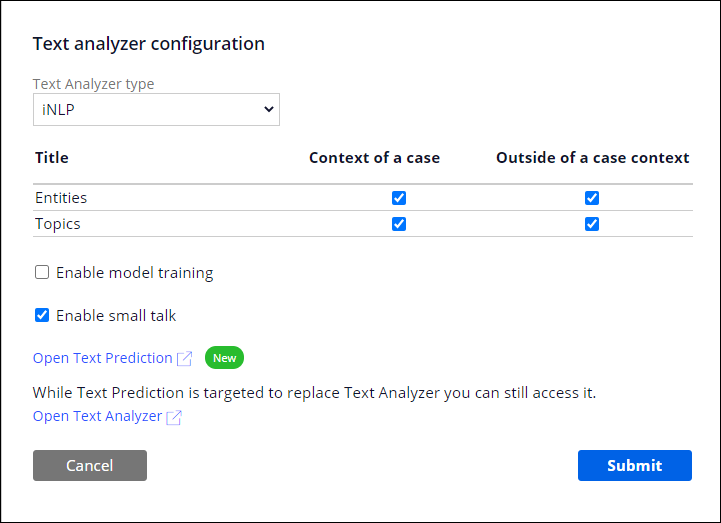Adding a text analyzer for an email bot
To improve the artificial intelligence of Pega Email Bot™ and its ability to detect the correct information from emails, you can configure one or more advanced text analyzers for an application. In this case, the text analyzers examine user input one by one, until the system finds a response.
For example, you can configure the first text analyzer to detect only entities or topics in the email body, another one to detect only entities or topics in the email attachments, and a third analyzer to detect entities or topics in both the email body and attachments.- In the navigation pane of App Studio, click Channels.
- In the Current channel interfaces section, click the icon that represents your existing Email channel.
- In the Email channel, click the Behavior tab.
- In the Text Analyzer section, select the Use
advanced configuration checkbox.In the advanced configuration mode, you configure the advanced text analyzers that use natural language processing (NLP) and adaptive and predictive analytics. If you do not use advanced configuration, you configure the default text analyzer that exactly matches user input to a response. For more information, see Exploring text predictions and text analyzers.
- In the Text Analyzer section, select a method for
configuring a text analyzer:
- To create a text analyzer, click Add text analyzer.
- To edit an existing text analyzer, click the Switch to edit mode icon next to the text analyzer that you want to edit.
- In the Text analyzer type list, select and configure a
text analyzer:
Choices Actions Pega NLP Configure an advanced text analyzer that uses the best approximate match by using advanced natural language processing (NLP) and artificial intelligence:
- Select whether to detect entities or topics in the context of the email body, attachments, or both.
- In the Text analyzer rule field, select or enter a text analyzer rule.
- To modify the text analyzer rule settings, click
Open Text
Prediction.For more information, see Building text analyzers.
- To modify the text analyzer rule settings, click
Open text analyzer in Dev Studio, make changes,
and then in the lower-left of the page click Back
to Pega App Studio.
The option to modify the text analyzer rule is only available if you have access to Dev Studio.
For more information, see Building text analyzers.
iNLP Configure an advanced intelligent NLP text analyzer / text prediction that uses adaptive analytics text analysis:
- Select whether to detect entities or topics in the context of the email body, attachments, or both.
- To modify the text prediction settings, click
Open Text
Prediction.For more information, see Analyzing messages with text predictions.
- To modify the text analyzer rule that underlies the text
prediction, click Open text analyzer in Dev Studio, make changes,
and then in the lower-left of the page click Back
to Pega App Studio.
The option to modify the text analyzer rule is only available if you have access to Dev Studio.
For more information, see Building text analyzers.
This type of analysis integrates text analytics with strategies, propositions, and interaction history to provide the context for making better next-best-action decisions. For more information, see Customizable Interaction API for text analytics.
- Optional: To enable subject analysis in email, select the Enable subject
analysis checkbox.For more information, see Enabling subject analysis in email.
- Optional: To enable email attachments analysis in email, in the Analyze email
attachments list, specify how you want to analyze email
attachments:
- To always analyze email attachments, click Always.
- To analyze email attachments based on a when rule, click When, and then in the adjacent field select or define a when rule.
For more information, see Enabling email attachments analysis during email triage. - Click Submit.
- Optional: To add or configure more text analyzers for the email bot, repeat steps 5 through 9.
- Click Save.
Previous topic Configuring a text prediction for an email bot Next topic Defining topics for text analysis for an email bot

